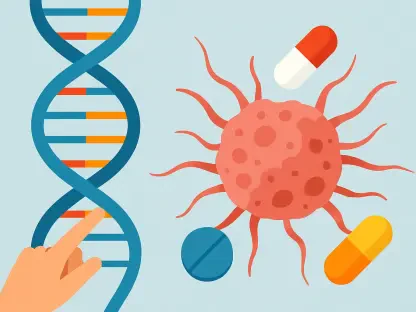Ivan Kairatov is an esteemed biopharma expert with extensive knowledge in technological innovation within the industry, particularly in research and development. Today, we’ll delve into the recent FDA approval of Regeneron’s Lynozyfic for multiple myeloma and its implications for patients and future treatments.
Can you provide an overview of Lynozyfic and its mechanism of action in treating multiple myeloma?
Lynozyfic is a cutting-edge bispecific antibody that targets multiple myeloma. Its primary action involves bridging the B-cell maturation antigen on myeloma cells with CD3-expressing T-cells. This interaction effectively activates the T-cells, facilitating the targeted killing of cancer cells, which is crucial for patients with limited treatment options.
What specific criteria must patients meet to be eligible for Lynozyfic treatment?
To qualify for Lynozyfic, patients must have undergone at least four prior lines of therapy. This includes treatments with a proteasome inhibitor, an immunomodulatory agent, and an anti-CD38 monoclonal antibody. This criterion ensures that Lynozyfic is reserved for those who have relapsed or are refractory to these existing treatments.
What are the statistics regarding the number of new multiple myeloma cases expected in the US this year?
This year, it is anticipated that over 36,000 new cases of multiple myeloma, a formidable yet incurable blood cancer, will be diagnosed in the United States. This statistic underscores the pressing need for innovative treatments like Lynozyfic.
How many multiple myeloma patients in the US experience disease progression after three or more therapies?
Within the US, approximately 8,000 patients have disease progression after three lines of therapy. For patients who have undergone four or more therapies, around 4,000 continue to experience disease progression. These numbers highlight the critical need for advanced treatments in heavily pre-treated populations.
Can you explain what a bispecific antibody is and how Lynozyfic utilizes this technology?
A bispecific antibody is designed to bind two different antigens simultaneously. Lynozyfic leverages this technology by connecting B-cell maturation antigen on myeloma cells with CD3 on T-cells. This bridging activates the T-cells, directing them to attack and kill the myeloma cells, which is a pivotal advancement in targeted cancer therapy.
What were the key findings of the phase 1/2 LINKER-MM1 trial that supported the FDA’s accelerated approval of Lynozyfic?
The LINKER-MM1 trial revealed a notable 70% objective response rate, with a complete response rate of 45%. These outcomes were significant in a patient group that had been heavily pre-treated, underscoring Lynozyfic’s potential as a new treatment standard.
What does the term “objective response rate” mean in the context of the trial results?
The objective response rate (ORR) measures the proportion of patients whose cancer shrinks or disappears after treatment. In the LINKER-MM1 trial, Lynozyfic demonstrated a 70% ORR, indicating its ability to elicit a substantial reduction in tumor size or complete remission in a considerable fraction of patients.
What can you tell us about the median time to first response and the duration of response seen in the trial?
In the trial, the median time to first response was a swift 0.95 months, reflecting Lynozyfic’s rapid action. Although the median duration of response wasn’t reached, it was notable that 89% of responders maintained their response at nine months and 72% at twelve months, showcasing promising durability.
What role does the FDA’s accelerated approval pathway play in Lynozyfic’s approval, and what are the requirements for continued approval?
The FDA’s accelerated approval allows Lynozyfic to be made available sooner based on promising early data. Continued approval hinges on Lynozyfic demonstrating clinical benefit through confirmatory trials, ensuring that initial results translate to long-term patient benefits.
Besides treating relapsed or refractory multiple myeloma, what other potential applications are being explored for Lynozyfic?
Research is underway to assess Lynozyfic’s efficacy in different myeloma lines, including earlier stages and various plasma cell disorders. These investigations could broaden its use and impact, offering hope to more patient subsets.
How is Regeneron planning to expand the clinical development program for Lynozyfic?
Regeneron is expanding Lynozyfic’s clinical program to explore its potential as both a monotherapy and in combination therapies. This comprehensive approach aims to improve patient outcomes in diverse treatment settings and uncover new therapeutic avenues.
What impact do you expect Lynozyfic to have on the standard of care for multiple myeloma, based on current data?
With a substantial response rate, Lynozyfic is positioned to redefine treatment standards for heavily pre-treated multiple myeloma patients. Its ability to induce responses where conventional therapies may fail marks a significant shift in management strategies.
Are there any ongoing or planned confirmatory trials for Lynozyfic?
Yes, there are planned confirmatory trials to validate Lynozyfic’s clinical benefit further. These trials are crucial for securing ongoing FDA approval and ensuring that initial promising results lead to long-term patient benefits.
How might Lynozyfic fit into combination therapies or earlier lines of treatment for multiple myeloma?
There is great potential for Lynozyfic to enhance treatment regimens as evidence from trials unfolds, particularly as part of combination therapies or earlier lines of treatment. These prospects could significantly affect patient care strategies, potentially improving outcomes and extending patient lives.
Could you discuss any other plasma cell disorders that Lynozyfic may potentially address?
As Lynozyfic undergoes further evaluation, its potential to treat other plasma cell disorders is being explored. These expansions could provide breakthrough options for patients with limited treatment possibilities beyond multiple myeloma.
What is your forecast for the future of treatments like Lynozyfic in the biopharmaceutical landscape?
I foresee treatments like Lynozyfic becoming pivotal in the biopharma landscape. As we continue to harness bi-specific technologies, the potential for personalized and effective therapies expands, likely transforming how we approach not just multiple myeloma, but a variety of challenging diseases.









